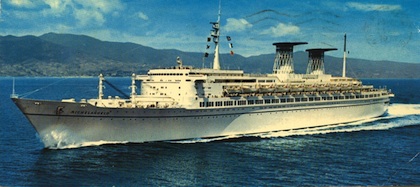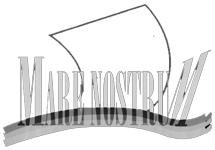LE T/N “MICHELANGELO” – “RAFFAELLO”
LE ULTIME NAVI DI LINEA
Il gigantismo del Rex e del Conte di Savoia aveva già dimostrato quanto il prestigio internazionale avesse un costo notevole superiore ai ricavi d’esercizio. Tuttavia l’errore fu ripetuto con l’impostazione delle turbonavi Michelangelo e Raffaello l’otto novembre 1960.
Ciò avvenne nonostante alcuni segnali negativi avessero già indicato un calo di passeggeri sulla linea del Nord America, pari al 26%.

La T/n Michelangelo in arrivo a Genova
I due transatlantici rappresentarono, in ogni caso, l’espressione più avanzata della tecnologia applicata alle linee architettoniche interne ed esterne, ai modernissimi impianti e macchinari, alle strumentazioni nautiche e dotazioni varie; parametri che accreditarono la loro più alta classificazione in materia di sicurezza della navigazione.
|
Nave– Ship |
Stazza L.-G.T |
Lungh.-L.o.a. |
Largh.-Bread |
Potenza– H.P. |
Pass. |
|
Michelangelo |
45.911 |
275,81 mt. |
31,05 mt. |
87.000 CV |
1775 |
|
Raffaello |
45.933 |
|
|
|
|

Le due grandi navi di linea s’incontravano spesso a Genova
I migliori artisti, arredatori, stilisti e decoratori italiani diedero, nel rispetto di una lunga tradizione, un espressivo contributo d’immagine all’arte itinerante del nostro Paese.
La Michelangelo, costruita a Genova, partì per il suo viaggio inaugurale il 12 maggio 1965, precedendo d’alcuni mesi la sua gemella Raffaello, costruita a Monfalcone e che fu pronta a partire il 25 luglio 1965, anch’essa sulla linea di New York.
Le due unità, nonostante il sostegno di un’imponente battage pubblicitario, furono ridimensionate da alcuni insuccessi che ebbero altrettanta enfasi sui media.
La Michelangelo, dopo alcune traversate oceaniche, dovette sostituire le eliche, causa d’intense vibrazioni e scarsa velocità.

Il 12 aprile 1966 fu il giorno della tristemente nota “onda anomala” che sfondò il ponte di comando della T/n Michelangelo, uccise due persone e ne ferì molte altre, tra cui il Comandante in 2a Claudio Cosulich di Trieste.
Il 31 ottobre 1965 la Raffaello subì un incendio in sala macchine e dovette rinunciare al viaggio. Il 17 ottobre 1966 subì una grave avaria ad una caldaia.

La T/n Raffaello in manovra d’ormeggio a Genova aiutata dai rimorchiatori Tripoli e Alghero.
Il 19 maggio 1970 entrò in collisione con una petroliera ad Algesiras (Gibilterra). Il 28 settembre 1973 dovette sospendere il viaggio per un’avaria all’apparato motore.
UNA FINE ANNUNCIATA
“1.600.000 PASSE,GGERI TRASPORTATI IN UN ANNO”
Fu il titolo del manifesto pubblicitario diffuso dalla Compagnia Aerea Americana Pan-Am., per l’esercizio ’70-71.

La Michelangelo e la Raffaello in disarmo alla fonda nella baia di Portovenere alla fine del 1975.
L’annuncio rappresentò l’irriverente necrologio per l’intero settore marittimo mondiale del trasporto di linea passeggeri.
Le costruzioni delle Michelangelo e Raffaello costarono circa 100 miliardi di lire e nel 1973 le perdite di gestione ammontarono a 30 miliardi.
I due transatlantici furono fermati, disarmati, rimorchiati ed ormeggiati nella baia di Portovenere alla fine del 1975, nell’attesa di compratori.
Nel 1977 furono acquistate dal Governo dello Shah di Persia.
La Michelangelo funzionò da caserma militare nel porto di Bandar Abbas e terminò la sua esistenza nel 1991 in un Cantiere di demolizione pachistano.
La Raffaello, adibita anch’essa a struttura militare, affondò nel febbraio 1983 sotto i bombardamenti aerei iracheni.
THE LAST LINERS
THE T/S “MICHELANGELO” – “RAFFAELLO”
The giant liners M/v “REX” and “CONTE di SAVOIA” had already demontrated how international prestige involved considerable higher costs to what they derived from incomes.
However, the same error was repeated with the bringing into service of the turbo vessels Michelangelo and Raffaello on 8 November 1960.
This took place even though there had been negative signals in the reduction of passengers by some 26%, on the North American line.
The two transatlantic liners represented anyway, a more advanced technical expression applied to the architectural lines both inside and out, to the very modern plants and machines, to the nautical instruments and various equipments, and parameters which gave credit to the highest classification regarding navigational security matters.
The best italian artist, interior designers, stylists and decorators, in respect of their long traditions, contributed an expressive and imaginative interpretation artwise, which is part of our country.
The Michelangelo built in Genoa, sailed on her maiden voyage on 12 May1965, to New York followed by the sister vessel Raffaello, built at Monfalcone. Her maiden voyage to New York was on 25th July 1965. Both liners covered the North American Line.
The two units, even starting with the support of an impressive mass of publicity, due to some unsuccessful events, saw their popularity diminished as they were over emphasized by the mass media.
The Michelangelo after a few transatlantic voyages, had to replace the propellers, caused by intense vibration and a scarse speed. On the 12 April 1966 was the day much publicised anomalous wave,
which shattered the command bridge, killing two persons and injuring many others.
The Raffaello on 31 October 1965, had a fire in the Engine Room and had to renounce the voyage. On 17 October 1966 she underwent bad damage to a boiler. On the 19 May 1973 she had a collision with a petrol tanker at Algesiras, Gibraltar. On the 28th September 1973 she had to suspend a voyage due to damages to the engine’s pumps.
THE ANNOUNCED CLIMAX
1.600.000 passengers transported in one year, was the contents of the publicity circulated by the American Airways PAN AM for the year 1970-71. The announcement represented, the irriverent obituary for the entire world maritime transport section of the passenger liners.
The contruction costs of the Michelangelo and Raffaello came to about 100 miliards of lires and in 1973 the management costs amounted to 30 miliards.
At the end of 1975 the two transatlantic liners were withdrawn from service, dismantled and towed to Portovenere Bay (La Spezia) where they were put into lay-up awaiting potential buyers.
In 1977 they were bought by the Government of the Shah of Persia. The Michelangelo was used a military base in the Bandar Abbas port. Her existence terminated in 1991 when a Pakistan shipyard bought her for demolition and broke her up.
In February 1983 the Raffaello which had also been adapted for militarry use, was sunk during an Iraq air bombardment.
Carlo GATTI
Rapallo, 12.02.12
